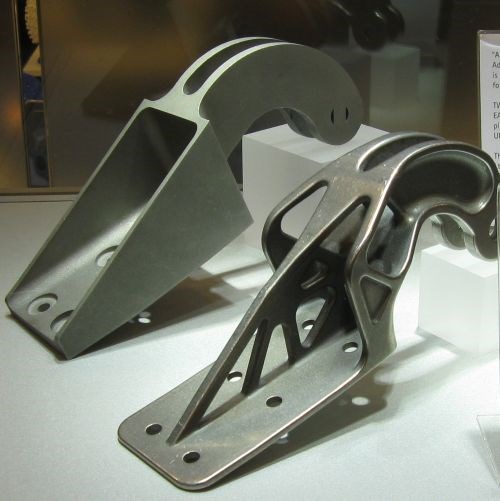Optimizing Mass and Material
Most machined parts have more material than necessary. This is true even after all of the cutting is finished.
Share
Read Next

Machined parts often have more material than necessary. This is true even after all of the cutting is finished. In fact, it might be that most machined parts have more material than necessary. This is true because the part, in general, only has to mate with its required connections and carry its required stresses. Any material not necessary for these purposes is superfluous.
Still, we don’t usually know what that unneeded material is. We don’t typically model a part’s precise pattern of stresses to find out, because the information would have no practical use. A part tailored to the stresses it actually carries might look like the nearer of the two parts in this photo. Machining offers no practical way to make such an odd shape. However, additive manufacturing does.
This part, in both of the versions seen here, is a component of a hinge for a maintenance access hatch on an aircraft. The farther version is the traditional form of this part, produced through casting and machining. By contrast, the nearer version was optimized for its function using software from Altair then built additively using a direct metal laser sintering machine from EOS. Producing an optimal design in this way resulted in a part that weighs less and requires less material, even though it is still every bit as functional as the part that was machined. For much more on the redesign of this part for additive manufacturing, see this paper.
Related Content
-
Additive Manufacturing Is Subtractive, Too: How CNC Machining Integrates With AM (Includes Video)
For Keselowski Advanced Manufacturing, succeeding with laser powder bed fusion as a production process means developing a machine shop that is responsive to, and moves at the pacing of, metal 3D printing.
-
Aircraft Engine MRO: How Additive Manufacturing Plus Robotic Finishing Will Expand Capacity for Blade Repair
AM offers the chance to bring fast, automated processing to individualized, part-by-part restoration of turbomachinery. A cell developed by Acme Manufacturing and Optomec is able to automatically repair 85,000 unique aircraft engine blades per year.
-
6 Reasons Space Exploration Will Need Additive Manufacturing
There are at least half a dozen ways 3D printing will contribute to space travel, research and habitation — and in some cases it already is. Insights from seminar focused on manufacturing challenges for the space sector.

.jpg;width=70;height=70;mode=crop)










